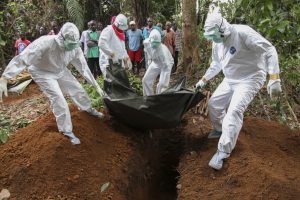The 2014 Ebola Outbreak claimed about 11,000 lives and transcended country borders. Ebola presents with frightening symptoms: more frightening was that it kept spreading. Thanks to Anthropologists, health officials knew why: local burial practices endangered the lives of those partaking in burial rituals. We will look at how those practices influenced Ebola policies and procedures:
Initial Resistance
When the first responders to Ebola came to Guinea, Sierra Leone and Liberia, they were determined to stop Ebola’s transmission at any cost. The Ebola virus is transferred through infectious bodily fluids, so foreign health officials took over disposing of the dead and developed a procedure to handle mass casualties. The African locals did not respond well to this practice, often resisting health officials’ efforts to bury the dead.
Anthropologists’ Observations
Anthropologists were tasked with understanding the locals’ resistance. Anthropologists discovered common practices and beliefs among locals:
- Handling of the body with the bare hands
- “Love Touch”: loved ones either touch the face or lie on top of the deceased in order to unify the living and ancestral spirits, and even receive spiritual gifts from the deceased.
- Importance of a proper burial: many locals believe in life after death. If a proper burial does not occur, then the deceased cannot achieve spirithood, and therefore the angry spirit will return and punish the living relatives.
- Mistrust of government: foreign health officials had to have communicated with the government to assist, so many Africans thought their governments did not respect them. As a result, many locals mistrusted their leaders and did not want to comply.
Solution
Anthropologists realized that in isolating deceased Ebola victims, the health officials were dishonoring locals’ culture and beliefs. Anthropologists relayed these findings to policymakers, who formed coalitions with government officials, tribal and religious leaders in order to come up with burial techniques that would honor the dead and living while halting Ebola. As a result, locals allowed their leaders and foreign officials to assist and Ebola transmission slowed. It was one of the first times that foreign health officials recognized that religious and cultural practices and political beliefs strongly influence health promotion techniques on an epidemic level. They adjusted their procedures accordingly.
Evaluation
It was important to recognize the cultural factors at play, but was recognition and adjustment too late? How many have to die before world aid organizations adjust their policies and procedures to accommodate many different cultures and societies? Although these organizations are powerful, they sometimes adopt a “savior” mentality, and forget that they can still learn. Another outbreak could happen: public safety is of great importance, but so is cultural relativism.
Works Cited:
Manguvo, Angellar and Benford Mafuvadze.”The Impact of Traditional and Religious Practices on Spread of Ebola in West Africa.” The Pan African Medical Journal. Vol 22 Issue 9. 10 October 2015. Accessed 12 March 2017. https://www.ncbi.nlm.nih.gov/pmc/articles/PMC4709130/
Maxmen, Amy. “How the Fight Against Ebola Tested a Culture’s Traditions.” National Geographic. 30 Jan 2015. Accessed 12 March 2017. http://news.nationalgeographic.com/2015/01/150130-ebola-virus-outbreak-epidemic-sierra-leone-funerals/


4 responses to “Ebola: Public Safety Issue or Cultural Violation?”